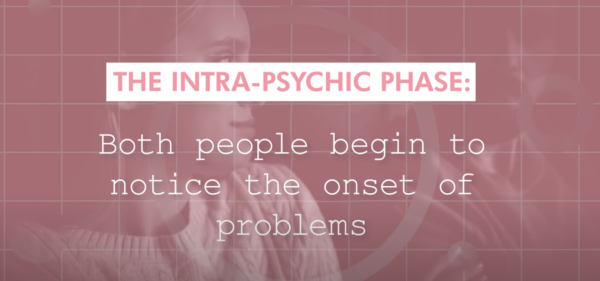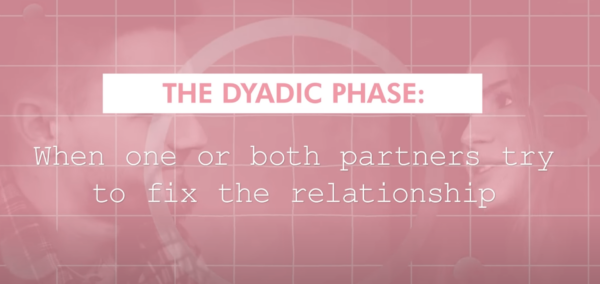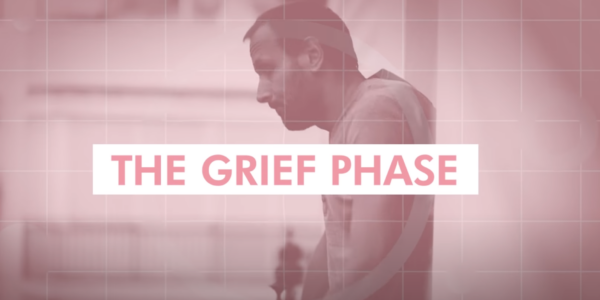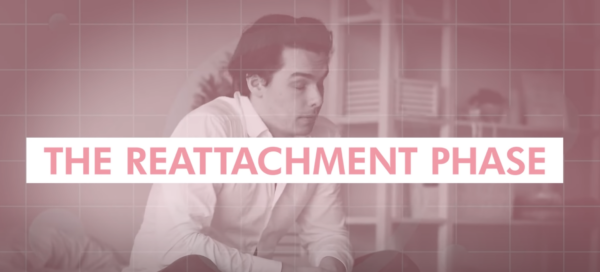Today I’m going to tell you exactly when you can expect the breakup to hit the dumper.
Luckily, I have a decade worth of experience and success stories from our program to draw from.
What is interesting is that we find the breakup truly won’t hit the dumper until they feel they have lost the dumpee forever.
To illustrate this theory I’ve put together five distinct phases that you can expect a dumper to go through and I’m going to pinpoint the exact moment when the breakup begins to hit them.
In short those five phases are as follows,
- The intra-psychic phase
- The dyadic phase
- The grief phase
- The reattachment phase
- The acceptance phase
Let’s begin by dissecting these phases.
Phase One: The Intra-Psychic Phase
Before the actual breakup occurs seems like an odd place to start a “when does the breakup hit the dumper” article but it’s the right place to start.
The intra-psychic phase is all about both parties in a relationship acknowledging that their are problems in that relationship.
For an avoidant this would definitely be the point in which they determine that they want to get out of a relationship or at least have the idea to.
Yet they’re often too afraid to act and so the relationship continues.
I think this is super important to include because what I notice is that the longer this phase occurs the harder it is for an ex to have nostalgia about the “good points” of the relationship.
Instead, they think back to the anxiety or discomfort they feel during this phase and are often freaked out by it.
Of course, it’s important to keep in mind that “freak out” mentality won’t last forever.
Phase Two: The Dyadic Phase
Here is where we enter into the phase in which one or both parties desperately tries to solve the issues in the relationship.
Of course, this is usually fruitless because they fail to acknowledge the true problems that caused the breakup in the first place. The best analogy I’ve heard is that it’s a little like trying to use a band aid to fix a bullet wound.
From an avoidant perspective (remember most exes we are finding are avoidant) this is the phase where it can seem like their partner is pushing too hard which ultimately causes them to back away and grow afraid.
In some cases this is the phase where they end up breaking up with you.
Phase Three: The Grief Phase
Understanding the intricacies of how the anxious and avoidant dynamic work are really important here.
I made mention of this in phase two but most of our clients have anxious attachment styles and most of their exes have avoidant attachment styles.

What Are Your Chances of Getting Your Ex Boyfriend Back?
Take the quizIf you need a crash course in what these are I recommend reading our complete guide on attachment styles.
What’s interesting about the grieving process of both is that they both grieve during separate times. Most people tend to think that those with an avoidant attachment won’t grieve at all and that’s not true.
They will grieve but it happens later.
To further illustrate this point I recorded a video earlier this year talking about that exact concept.
Basically the video talks about this concept of nostalgic reverie and how those with an avoidant attachment style don’t really begin to miss their exes until they feel that ex has moved on.
This will be an important component to talk about in the next phase but ultimately I’ve noticed that exes who dump you and have avoidant styles tend to distract themselves from thinking about the pain in various ways.
- Cutting off communication with you
- Moving on to someone new
These are all common ways for them to not think about the breakup.
Now, when you juxtapose that with someone who has an anxious attachment style who does all their grieving on the outset of the breakup.
They beg…
They cry…
They beg again…
Until eventually they realize that isn’t going to work and move on.
That anxious behavior is part of their grieving cycle.
It’s During This Phase That For The Avoidant Will Feel The Breakup
It’s during this grieving phase that most exes will begin to feel the breakup.
As stated, most of our clients exes have avoidant tendencies from an attachment style perspective. Well, it’s at this point that the avoidant finally allows themselves time to grieve and the true “force” of the breakup begins to hit them.
That’s not to say that they will want you back immediately.
But they will begin to look back on their time with you and regret that they don’t have that experience anymore.
Let’s move on to the next phase.
Phase Four: The Re-Attachment Phase
Here’s the truth that many of my peers are maybe a little afraid to admit to you.
If you are trying to get your ex back there is literally only brief pockets of time that appear in which this is possible.
Sometimes these brief pockets of time appear and disappear only to re-appear years later.

What Are Your Chances of Getting Your Ex Boyfriend Back?
Take the quizThese pockets of time are known as the “re-attachment phase.”
Essentially it’s the point of time where they begin to grow very attached to your time together and that wave of nostalgia can become so strong that they begin to yearn for a return of it.
It’s this phase that our entire ex recovery program is built around.
Which brings us to our final phase.
Phase Five: The Acceptance Phase
Think for a moment about the roller coaster of emotions that have just unfolded amongst these five phases.
One or both parties recognize there are problems in the relationship.
One or both parties try to fix those problems but it’s ultimately for naught.
Both go about grieving in their own ways.
Eventually nostalgia kicks in and they begin to want more again.
But if there is no progress on that front eventually they accept that the relationship is over and begin the process of moving on.
This is also known as the acceptance phase.
It’s a little like the five stages of grief if you think about it. Perhaps the biggest insight I can leave you with the acceptance phase is that sometimes people fall off the wagon. They think they are over their exes only to be out one day and see something that reminds them of their ex and they fall off the wagon.
These Five Phases Can Happen Out Of Order
One of my biggest gripes with the concept of the five stages of grief is everyone thinks that they occur in order but in many cases if you look at your own experience you’ll find that’s not the case.
One minute you can be angry and the next you can accept that it happened only to fall off the wagon again to get angry again.
Grief is not a linear process.
It evolves depending on our circumstances.
The same can be said about these phases that I talked about in this article.
You’ll find that your exes experience during them will jump around.
One minute they’ll have this huge wave of nostalgia and the next they’ll want nothing to do with you.
It’s entirely possible for them to repress their feelings only to have the breakup hit them months down the road. After they “fall off” they will stuff their feelings down deep inside for another few months only to fall off the wagon again.

What Are Your Chances of Getting Your Ex Boyfriend Back?
Take the quizThese phases aren’t linear.
Remember that.
Conclusion
Generally speaking your ex isn’t going to “feel” the breakup until after they feel they have lost the dumpee forever. This is further backed up by our research on avoidant attachment styles.
You can expect your ex to go through the five following phases after a breakup.
- The intra-psychic phase: Where one or both parties begin to notice the onset of problems.
- The dyadic phase: Where one or both parties try to fix the problems (often with little success.)
- The grief phase: Where grieving occurs at different rates depending on your attachment styles.
- The reattachment phase: Where the wave of nostalgia hits and they begin to miss you deeply.
- The acceptance phase: Where they realize that it’s time to move on.
Generally speaking you can expect the dumper to truly feel the breakup during the grief phase or the re-attachment phase.
Each dumper is unique.
Oh, and don’t forget.
Sometimes they’ll jump around the stages.




